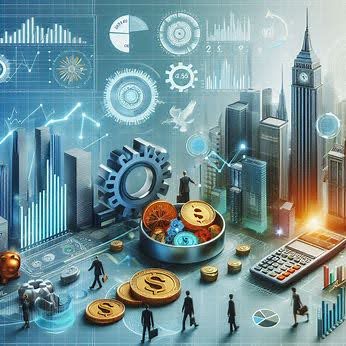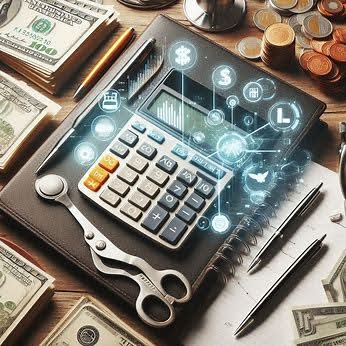Gross Domestic Product (GDP) is one of the most critical and widely used indicators in economics. It serves as a comprehensive measure of a country’s overall economic activity, providing insights into the health of the economy and guiding policymakers, investors, and analysts in their decision-making processes. This article explores the definition of GDP, its components, types, calculation methods, and its importance in the global economic landscape.
1. Definition of GDP
Gross Domestic Product (GDP) represents the total monetary value of all finished goods and services produced within a country’s borders in a specific time period, typically calculated on an annual or quarterly basis. It includes all private and public consumption, government outlays, investments, and net exports (exports minus imports) that occur within a country.
2. Components of GDP
GDP can be broken down into four main components, each representing a different sector of the economy:
a. Consumption (C)
Consumption refers to the total value of all goods and services consumed by households. This includes expenditures on durable goods (e.g., cars, appliances), nondurable goods (e.g., food, clothing), and services (e.g., healthcare, education). Consumption is typically the largest component of GDP.
b. Investment (I)
Investment includes spending on capital goods that will be used for future production. This encompasses business investments in equipment and structures, residential construction, and changes in business inventories. Investment is crucial for economic growth as it increases the productive capacity of the economy.
c. Government Spending (G)
Government spending represents the total government expenditures on goods and services. This includes spending on defense, education, public safety, and infrastructure. It does not include transfer payments such as pensions and unemployment benefits, which are not made in exchange for goods or services.
d. Net Exports (NX)
Net exports are calculated as the difference between a country’s exports and imports. Exports add to GDP as they represent production within the country, while imports are subtracted since they represent spending on foreign-produced goods and services.
The formula for GDP using these components is:
\[ \text{GDP} = C + I + G + (X – M) \]
where \(X\) represents exports and \(M\) represents imports.
3. Types of GDP
There are several types of GDP, each providing different insights into the economy:
a. Nominal GDP
Nominal GDP is the total value of all goods and services produced in a country, measured at current prices. It does not adjust for inflation, which means it can be influenced by changes in price levels.
b. Real GDP
Real GDP adjusts for inflation and reflects the value of all goods and services produced in a country, measured at constant prices. This adjustment provides a more accurate representation of an economy’s size and how it’s growing over time.
c. GDP Per Capita
GDP per capita divides the GDP by the population of the country, providing an average economic output per person. It is often used as an indicator of the standard of living and economic well-being of the population.
4. Calculation Methods
There are three primary methods to calculate GDP, each offering a different perspective on the economy:
a. Production (Output) Method
The production method calculates GDP by summing the value added at each stage of production of all goods and services. Value added is the difference between the output of a sector and the intermediate consumption (inputs).
b. Income Method
The income method calculates GDP by summing all incomes earned by individuals and businesses in the economy, including wages, profits, rents, and taxes, minus subsidies.
c. Expenditure Method
The expenditure method calculates GDP by summing all expenditures made in the economy, using the formula:
\[ \text{GDP} = C + I + G + (X – M) \]
5. Importance of GDP
GDP is a crucial indicator for several reasons:
a. Economic Performance
GDP provides a broad measure of a country’s economic performance. It helps to understand how well the economy is functioning and whether it is growing, stagnating, or contracting.
b. Policy Making
Policymakers use GDP data to make informed decisions regarding fiscal and monetary policies. For instance, during economic downturns, governments might increase spending or cut taxes to stimulate growth, based on GDP analysis.
c. Investment Decisions
Investors use GDP growth rates to assess the economic environment and make investment decisions. A growing GDP generally signals a healthy economy, which can lead to higher returns on investments.
d. International Comparisons
GDP allows for comparisons of economic performance between different countries. This helps in understanding relative economic strengths and weaknesses, influencing foreign investments, and trade policies.
6. Limitations of GDP
While GDP is a powerful tool, it has certain limitations:
a. Non-Market Transactions
GDP does not account for non-market transactions such as household labor and volunteer work, which contribute to economic well-being but do not involve market exchanges.
b. Informal Economy
GDP often underestimates the size of the informal economy, including unreported income and black-market activities.
c. Environmental Impact
GDP does not consider environmental degradation and resource depletion, which can have long-term economic and social consequences.
d. Quality of Life
GDP per capita gives an average economic output per person but does not account for income distribution, quality of healthcare, education, and other factors that contribute to the overall quality of life.
Gross Domestic Product (GDP) is a vital measure of economic activity, encompassing the total value of all goods and services produced within a country’s borders. By understanding its components, calculation methods, and types, one can gain valuable insights into the health and direction of an economy. Despite its limitations, GDP remains a cornerstone of economic analysis, guiding policymakers, investors, and economists in their efforts to foster sustainable economic growth and development.







